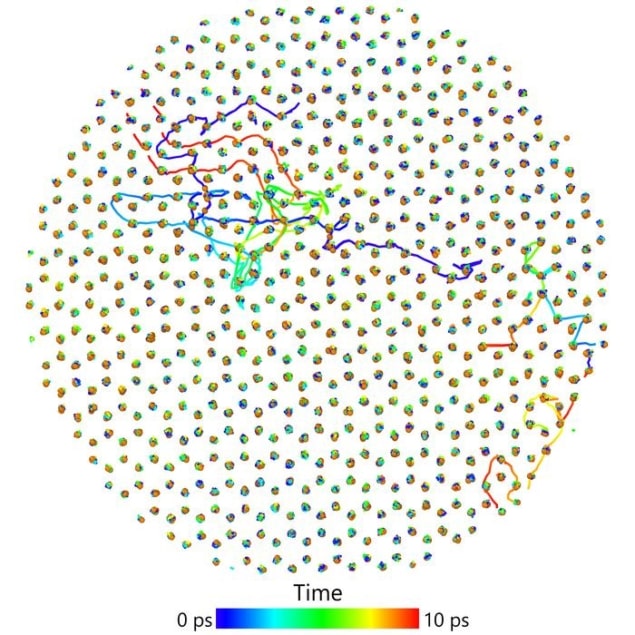Iron atoms in Earth’s inner core are on the move
29 Nov 2023 Isabelle Dumé
A model of iron atoms on the move in Earth's inner core. The model demonstrates how iron atoms are expected to move about in the Earth’s inner core over 10 picoseconds, or 10 trillionths of a second. (Courtesy: Zhang et al.)
Iron atoms at the centre of the Earth move much faster than was previously thought, say researchers in the US and China. The findings, which are based on machine-learning-assisted simulations of conditions in the Earth’s solid inner core, could shed fresh light on the core’s seismic and geodynamic properties, which are not fully understood.
The Earth’s inner core is mainly composed of solid iron, and it has several intriguing characteristics. For one, the velocity of shear waves – elastic waves that move through the body of a material – in the core is exceptionally low. The core also has an extremely high Poisson’s ratio, which is a measure of how easily it expands in a direction perpendicular to the direction of compression; at 0.45, the core’s Poisson’s ratio is closer to that of a liquid or a stretchy material such as rubber (0.5) than it is to steel or cast iron (0.21-0.31).
Artificial-intelligence-assisted approach
To uncover the physical mechanisms responsible for these unusual features, researchers led by Jung-Fu Lin at the University of Texas at Austin’s School of Geosciences began by using machine-learning calculations to simulate the behaviour of tens of thousands of iron atoms under the extremely high temperatures and pressures that prevail in the inner core. This artificial-intelligence-assisted approach allowed them to reliably predict the movement of the iron atoms under these conditions.
Next, they corroborated these simulations with a series of experiments that recreated the extremely high temperatures and pressures of the Earth’s inner core. By firing a fast-moving projectile onto a small iron plate and measuring the resulting shock waves, they were able to calculate the velocity of sound in iron atoms under inner-core conditions.
Collective iron atom motion
Although irons atoms in the inner core are thought to be arranged in a repeating hexagonal close-packed pattern, the researchers found that groups of iron atoms in their model systems can still move rapidly, changing their place in the metallic lattice while maintaining the overall hexagonal structure. According to the team, this collective motion could explain why seismic measurements of the inner core reveal an environment with a much lower shear wave velocity and a higher Poisson’s ratio that would be expected at such high temperatures and pressures.
“The big discovery that we’ve found is that solid iron become surprisingly soft deep inside the Earth because its atoms can move much more than we ever imagined,” explains team member Youjun Zhang of Sichuan University. “This increased movement makes the inner core less rigid [and] weaker against shear forces.”READ MORE

As well as explaining the exceptionally low shear wave velocity and ultrahigh Poisson’s ratio of the inner core, the result, which is described in PNAS, could also shed light on how the inner core helps power the Earth’s geodynamo. The energy from this dynamo generates our planet’s magnetic field – an essential component for making it habitable, since it protects life from harmful ionizing radiation in space.
The researchers now plan to extend their study to recently discovered exoplanetary interiors. “We also aim to investigate the effect on collective atom motion on a range of other properties that are essential to our understanding of the deep Earth,” Lin tells Physics World.

Isabelle Dumé is a contributing editor to Physics World
from physicsworld.com 9/4/2024

Δεν υπάρχουν σχόλια:
Δημοσίευση σχολίου